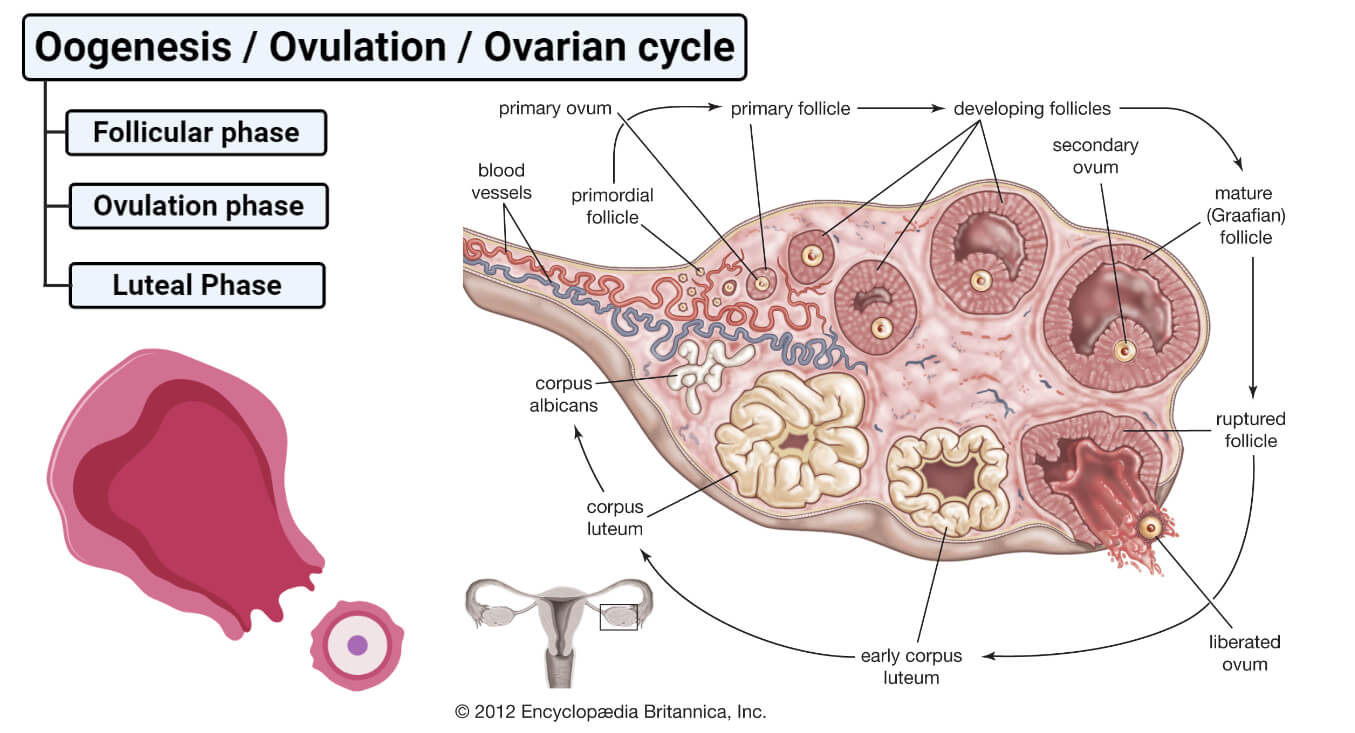Interesting Science Videos
Oogenesis Definition
Oogenesis is the female version of gametogenesis. It is the process of formation of female gamete or ovum, necessary for sexual reproduction.
- The process of oogenesis starts pre-natally, i.e. before the birth of the female child. It begins about 8-20 weeks after the fetus has begun to grow and goes on until the birth of the child.
- Thus, a newborn female child already has all the egg cells that are to be released from the ovaries during the reproductive life of the female. These cells are termed primary ova.
- The primary ova remain dormant until ovulation and become matured afterward. Some of these cells take as long as 40 years to mature while some reach maturation.
- The reproductive life of a female is characterized by the monthly periodic changes that occur in the release of sexual hormones as well as changes in the structure of ovaries as well as other sexual organs. This cyclic process is termed the female monthly sexual cycle.
- The process of oogenesis is described by the ovarian cycle, which is involved in the formation and maturation of female gamete.

Image Source: Britannica, Created with BioRender.com.
The ovarian cycle is divided into three phases:
A. Follicular phase
- After puberty, as a result of the release of a large amount of FSH and LH by the pituitary, the ovaries with the follicles start to grow.
- During the first stage, the targeted follicular cells enlarge up to two-fold to three-fold in diameter. These enlarged follicular cells are termed primordial follicles.
- After a few days, the level of FSH surpasses LH which accelerates the growth of 6-10 primary follicles that compete for dominance. Under the influence of FSH, these cells develop layers of granulosa cells as well as express the LH receptors on the granulosa cells.
- The second layer of cells called theca develops around these follicles which can produce other sex hormones like estrogen and progesterone.
- LH from the pituitary and the estrogen within the follicles cause accelerated growth of the primary follicles into vesicular follicles.
- The ovum present inside the follicles develops aggressively increasing in size another threefold to four-fold. After a week or more of growth, one of the follicles starts outgrowing other follicles (a process called atresia). The reason behind the process of atresia is not yet known; however, it is imperative as it prevents more than one child during pregnancy.
- The single follicle further increases in size and forms the mature follicle.
- The primary oocyte or ovum within the ovary remains as it is until it’s time to leave the ovary.
- The oocyte then undergoes meiotic division where the nucleus splits into two dividing the number of chromosomes in half. One of the two cells formed is usually larger than the other and is called the secondary oocyte, while the smaller one is called a polar body.
B. Ovulation phase
- Ovulation in women with regular 28 days sexual cycles occurs 14 days after the onset of menstruation. Few days before ovulation the follicle starts to swell with a protruding center called the stigma.
- The in-surge of LH hormone and the release of estrogen from the follicle degrades the cells at the stigma and results in a hole. The secondary oocyte leaves the follicle through the hole and reaches the peritoneal cavity. The secondary oocyte then reaches the fallopian tube through the fimbriae.
- It takes a few days for the transport of the ovum. The movement within the fallopian tube is aided by the peristaltic movement of muscles in the walls of the oviduct.
- The movement, however, also depends on the level of progesterone and estrogen. Progesterone accelerates the movement while estrogen arrests the movement of the ovum.
- If there is left-right coordination between the ovaries is not yet known. However, occasionally, both the ovaries release an ovum, which results in the formation of fraternal twins.
- If a sperm fertilizes the oocyte, it develops into a mature ovum. If fertilization doesn’t occur, the secondary oocyte degenerates within the fallopian tube.
C. Luteal Phase
- The luteal phase is the last phase of the ovarian cycle and it corresponds with the secretory phase of the uterine cycles.
- During the first few hours of ovulation, the remaining follicular cell, including the granulosa and theca develop into lutein cells. This cell then becomes filled with lipid components that give it a yellow appearance. The total mass of the cell is called corpus luteum.
- Corpus luteum produces progesterone that inhibits the release of FSH and LH by the pituitary. Consequently, the concentration of FSH and LH falls over time and the corpus luteum degenerates.
- The falling levels of progesterone then trigger menstruation. The process from the start of ovulation to the withdrawn of progesterone takes around two weeks. Even though the sexual cycle in all women is not the same; the duration of the luteal phase remains more or less the same in all women.
- In case of a successful pregnancy, the degeneration of the corpus luteum is prevented by the release of human chorionic gonadotropin(hCG) from the placenta. Corpus luteum is essential to produce progesterone which maintains the new pregnancy.
Refrences
- Hall JE and Guyton AC. (2011) Textbook of Medical Physiology. Twelfth Edition. Elsevier Saunders.
- Waugh A and Grant A. (2004) Anatomy and Physiology. Ninth Edition. Churchill Livingstone.
- Marieb EN and Hoehn K. (2013) Human Anatomy and Physiology. Ninth Edition. Pearson Education, Inc.
- Rastogi SC. (2007) Essentials of Human Physiology. Fourth Edition. New Age International Limited.
- https://www.britannica.com/science/oogenesis
- https://www.britannica.com/science/ovulation
